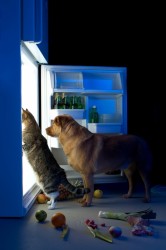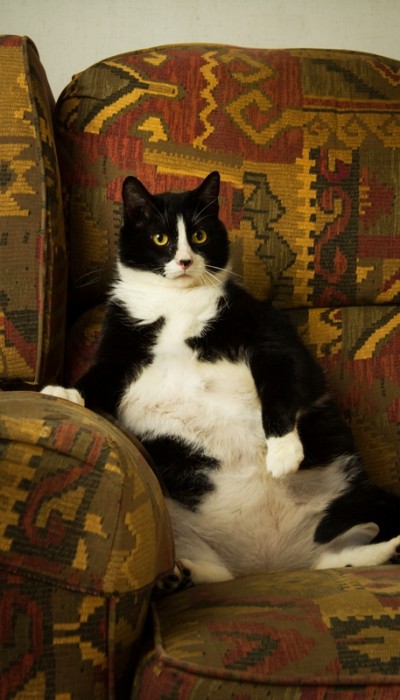Pet Weight Loss Is A Gain
PET WEIGHT LOSS
In Arthritis, I discussed how important it was to lose weight so that all that excess strain is taken off of the musculo-skeletal system. Pet weight loss, in the instance of hip dysplasia, can lead to a decrease in any anti-inflammatory drugs that were previously being taken.
The problem with weight gain is that it sneaks up on the pet. Over the lifetime of the animal, owners have often fed their pets too much food and the wrong type of it. Add insufficient exercise to this and the pet will gain weight. Calories in have to equal calories out for the animal to maintain its weight. Even a small amount of excess calories taken in monthly, over a lifetime, add up to way too much weight when the dog or cat is a senior! The last time I checked, pets can not do this:
THE EFFECT OF EXCESS WEIGHT
A middle aged animal may be able to get away with carrying excess weight but things change as the years go by. Excess weight puts too much strain on the body and the internal organs. The joints and bones of an animal can not tolerate too much strain due to excess weight. They can show early signs of joint disease and the animal starts limping. This is why pet weight loss is so important! Overweight animals also dehydrate quicker as they have less water in their bodies. This is something you do not want; particularly if they have borderline kidney issues.
Obesity also leads to: an increased risk of developing diabetes mellitus, increased strain on the heart and lung plus shortness of breath. Pets are also more susceptible to pancreatitis, heat stroke and a decreased life span. All of that fat has to go somewhere and that somewhere is excess deposition of abdominal fat and excess deposition of fat in the liver leading to eventual liver disease in the animal. This latter condition is very common in cats. The typical cat looks like the photo to the right. Obese cats eventually crash and lose tons of weight all due to fatty infiltration of the liver (hepatic) cells. Jaundice and many other metabolic conditions appear. They are very difficult to turn around.
FACTORS LEADING UP TO OBESITY
The reproductive status of the dog and cat is important. Spayed female dogs and cats are at the highest risk of gaining weight after a spay procedure. Immediate pet weight loss is crucial at this time. Reproduction and estrous burn tons of calories. Take that away plus the more sedentary lifestyle after surgery and the animal will gain weight. I normally have told most owners to watch the pets weight and if there is a gain we need to cut the calories some how and increase the level of exercise. Male dogs are not as prone to obesity as the female. They seem to be more active than the female after having been neutered.
I have noticed over the years that certain breeds of dogs are just plain predisposed to obesity. When has anyone ever seen an obese Jack Russell Terrier? They are so active that I think they sleep standing up! Breeds such as: Pugs, Dachshunds, Golden Retrievers, Labrador Retrievers, Cocker Spaniels and Beagles were some of the most obese prone dogs that I saw.
For those of you that have severe winters, pets do not get out enough to exercise. It is too cold, too icy and too much snow. Some pets do try but lose….In my Ohio practice I treated a Miniature Schnauzer for hypothermia after it got stuck in a snow bank for hours. With treatment, the pet did do well. The point is, most people and their pets exercise more in warm weather or those that live in a year round warm climate like Florida!
HOW TO GET THE POUNDS OFF MY PET!
Before you begin with any pet weight loss program, the family has to recognize that there is a weight problem. Ignoring the pet weight loss problem and hoping it is going to go away by just walking the pet 15 more minutes a day is not going to do it. First of all, be honest with yourself and this includes all family members. Write down what each person gives the animal on an average day. People have to have the will power to cut out the junk food snacks that are on the market. People eat food for comfort and they feed their pets s nibbles of cake, pizza, hot dogs and other rich foods because they want their pet to be happy. Again, it is a psychological thing. Tell yourself and family members that all junk food treats are to be stopped.
Here is a basic test to tell if your pet is obese and requires a pet weight loss program. Sure, go ahead and weigh the animal. You need to do this anyway so you know how far you have to go to reach an acceptable weight. First of all there should be a bit of a concavity over the abdomen of the dog or cat. An overweight dog will have a convex or outward bulging of the abdomen. In any dog or cat, using your thumb and index finger grab a section of the dog or cats skin over the chest. In a trim animal the amount of skin between your fingers should be a 1/4 of an inch or less. Anything over that indicates a need for pet weight loss. This test is usually quite reliable.
ACTUAL WEIGHT LOSS
Pet weight loss is best achieved by altering the diet and adding exercise. Dogs do not know how many cups of food you are giving them. If you feed once a day try cutting the food volume by 20% and divide the remainder into 2 equal meals. This will decrease calories and make the pet think it is getting 2 mega bowls of food a day. Feeding twice daily will help to satiate the animal. Try small amounts of walking at a time and do more as the animal starts to lose weight. This is a positive cycle. The more the dog loses, the more active it feels (not fighting gravity) and the more exercise it can tolerate which leads to more weight lost.
Weigh the pet weekly. For tiny pets and cats get a baby scale. For medium sized dogs weigh yourself and the dog on a bathroom scale and than weigh yourself. Subtract that from the former and you have the animals weight. For giant breeds, make a quick visit to your veterinarian’s office. Almost all have walk on scales and they will be happy to let you use it PLUS they can keep track of the pet weight loss in their medical records.
If that doesn’t work visit your veterinarian. He or she will probably suggest a prescription diet such as Hills® R/D or W/D. Both are offered in dry and wet. Usually, you can expect about 1-2 pound loss per month so a special diet will take a while. If the weight does not come off veterinarians will often suggest Slentrol® a Pfizer drug that decreases appetite and fat absorption. Before I do that I always draw blood and check the animals thyroid and adrenal functions. Adrenal diseases such as Cushing’s disease and Thyroid deficiency will both lead to weight gain.
Once the weight is off, give yourself a pat on the back. The trick is maintaining that new weight. Diets such as Hills® W/D, and similar products can be fed life long to maintain that happy “new” look!



